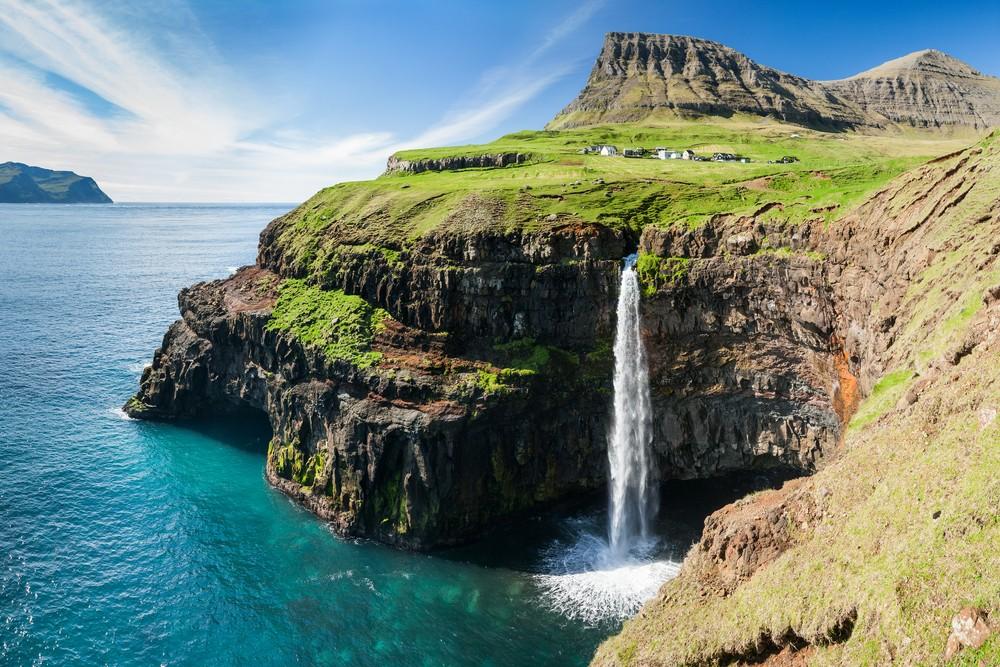

Travel information Faroe Islands
| Capital | Tórshavn |
|---|---|
| Form of government | : Parliamentary monarchy with self-government, parliamentary democracy |
| Currency | : Faroese krona |
| Area | approx. 1,395.74 km² |
| Population | approx. 50,318 (2017) |
| Languages | Faroese and Danish |
| Power supply | 220 volts, 50 Hz |
| Calling code | +298 |
| Time zone | UTC UTC+1 Daylight Saving Time (March to October) |
Important telephone numbers
- Emergency call (police, fire brigade, ambulance): 112
- Police: +298 351448
- Hospital in Tórshavn (Landssjúkrahúsið): +298 304500
- German Embassy in Copenhagen: +45 3545 9910 (The Faroe Islands are part of the Kingdom of Denmark)
German Doctors
- There are no German doctors in the Faroe Islands, but the Landssjúkrahúsið in Tórshavn offers comprehensive medical care.
The most important words with translation
- Hello – Hello
- Thank you – Takk
- Please – Vinaliga
- Yes – Yes
- No – Nei
- Sorry – Orsaka
- Where is…? – Hvar he…?
- How much does it cost…? – Hvussu nógv kostar…?
- Emergency – Neyð
- Doctor – Lækni
- Hospital – Sjúkrahús
Holidays
- New Year’s Day: January 1
- Easter Monday: variable (March/April)
- Labour Day: 1 May
- Constitution Day: 5 June (as part of Denmark)
- Assumption Day: 15 August
- National Day (Ólavsøka): 28-29 July
- Christmas: December 25
- St. Stephen’s Day: December 26
Opening hours
- Shops: Usually Monday to Friday from 10:00 to 17:30, Saturday from 10:00 to 14:00.
Closed on Sundays. - Supermarkets: Mostly daily from 9:00 a.m. to 6:00 p.m., some are also open on Sundays.
- Restaurants: Lunch from 12:00 to 14:00, dinner from 18:00 to 22:00.
- Banks: Monday to Friday from 9:00 a.m. to 4:00 p.m.
Airport
- Vágar Airport (FAE): The only airport in the Faroe Islands, about 2 km from the village of Sørvágur on the island of Vágar.
There are regular bus connections to Tórshavn.
Post / Stamps
- Post offices: In all major cities and towns. Main post office in Tórshavn.
Opening hours: Monday to Friday from 9:00 a.m. to 4:00 p.m. - Stamps: Available at the post office and in some kiosks and supermarkets.
- Costs for letters and postcards to Germany: Standard letter up to 50g: approx. 14 DKK (approx. 1.90 EUR); Postcard: approx. 14 DKK (approx. 1.90 EUR)
Safety
- Crime: The Faroe Islands are considered very safe.
However, usual precautions as in any tourist region are advisable. - Emergency number: 112
Current
- Voltage: 230 volts
- Sockets: Type C and K (as in Denmark)
Tip
- Restaurants: Tipping is not customary as service is included in the bill.
However, a small tip for good service is welcome. - Taxis: Round up the amount
- Hotels: 10-20 DKK per day for cleaning staff
Customs
- Allowances within the EU: The Faroe Islands are not part of the EU, so international customs regulations apply.
- Alcohol: Maximum 1 liter of spirits or 2 liters of wine.
- Tobacco: 200 cigarettes or 50 cigars or 250g of tobacco.
- Other items: Value up to DKK 3,250 (approx. EUR 436) duty-free.


